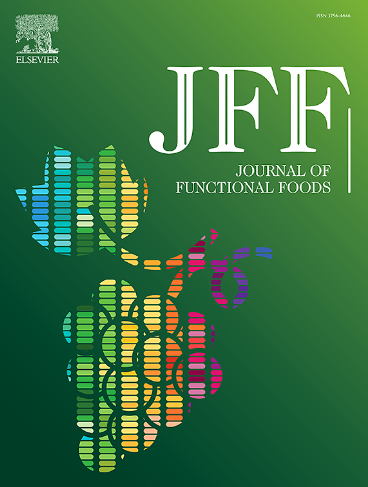火棘果提取物对化疗性血小板减少的保护作用及其潜在机制的转录组学分析
IF 4
2区 农林科学
Q2 FOOD SCIENCE & TECHNOLOGY
引用次数: 0
摘要
火棘果在中国传统上被视为一种膳食补充剂,因其对血液营养的益处而闻名。血小板减少症常与血虚有关。然而,关于金钱树果实的血小板增强作用的科学研究还很缺乏。本研究探讨了金钱树果实提取物(PFE)对化疗诱导的血小板减少症(CIT)的保护作用,并阐明了其血小板增强作用的分子机制。结果表明,PFE,特别是其乙酸乙酯组分(PFEEA)可显著提高血小板计数48.7%,减少出血和凝血次数,减少出血量。PFEEA还能减轻器官损伤,降低血清丙氨酸转氨酶水平。转录组学分析显示,PFEEA上调了造血细胞谱系通路中富集的基因,并使肝脏中造血相关细胞因子水平和血小板生成素mRNA表达正常化。本研究确定了PFE抗CIT的潜力,并提供了其机制的见解,支持其作为功能性食品的应用。本文章由计算机程序翻译,如有差异,请以英文原文为准。

Protective effects and potential mechanisms of Pyracantha fortuneana fruit extract on chemotherapy-induced thrombocytopenia revealed by transcriptomic analysis
Pyracantha fortuneana fruit is traditionally consumed as a dietary supplement in China known for its benefits in blood nourishment. Thrombocytopenia is often associated with blood deficiency. However, scientific studies on the platelet-enhancing activity of P. fortuneana fruit are lacking. This study investigates the protective effects of P. fortuneana fruit extract (PFE) against chemotherapy-induced thrombocytopenia (CIT) and elucidates molecular mechanisms underlying its platelet-enhancing effects. Results showed that PFE, particularly its ethyl acetate fraction (PFEEA), significantly increased platelet counts by 48.7 %, reduced bleeding and clotting times, and decreased bleeding volume. PFEEA also mitigated organ injuries and lowered serum alanine transaminase levels. Transcriptomic analysis revealed upregulation of genes enriched in the hematopoietic cell lineage pathway by PFEEA, along with normalization of hematopoiesis-related cytokine levels and thrombopoietin mRNA expression in the liver. This study establishes PFE's potential against CIT and provides insights into its mechanisms, supporting its application as a functional food.
求助全文
通过发布文献求助,成功后即可免费获取论文全文。
去求助
来源期刊

Journal of Functional Foods
FOOD SCIENCE & TECHNOLOGY-
CiteScore
9.60
自引率
1.80%
发文量
428
审稿时长
76 days
期刊介绍:
Journal of Functional Foods continues with the same aims and scope, editorial team, submission system and rigorous peer review. We give authors the possibility to publish their top-quality papers in a well-established leading journal in the food and nutrition fields. The Journal will keep its rigorous criteria to screen high impact research addressing relevant scientific topics and performed by sound methodologies.
The Journal of Functional Foods aims to bring together the results of fundamental and applied research into healthy foods and biologically active food ingredients.
The Journal is centered in the specific area at the boundaries among food technology, nutrition and health welcoming papers having a good interdisciplinary approach. The Journal will cover the fields of plant bioactives; dietary fibre, probiotics; functional lipids; bioactive peptides; vitamins, minerals and botanicals and other dietary supplements. Nutritional and technological aspects related to the development of functional foods and beverages are of core interest to the journal. Experimental works dealing with food digestion, bioavailability of food bioactives and on the mechanisms by which foods and their components are able to modulate physiological parameters connected with disease prevention are of particular interest as well as those dealing with personalized nutrition and nutritional needs in pathological subjects.
 求助内容:
求助内容: 应助结果提醒方式:
应助结果提醒方式:


